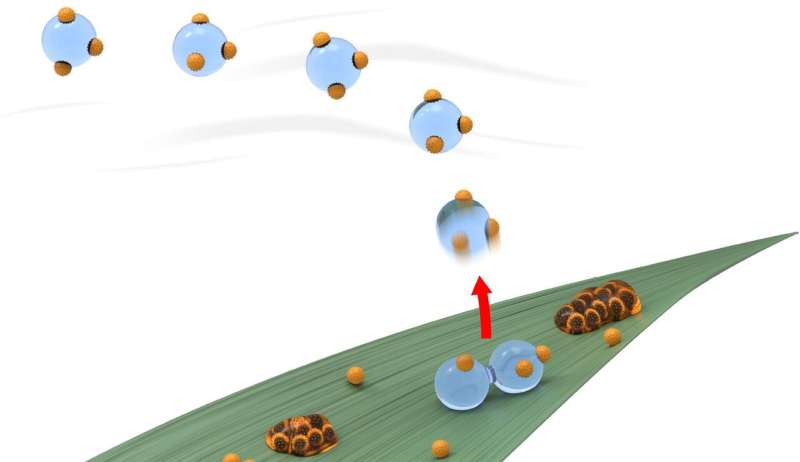June 19, 2019 report
Dew drops spontaneously flinging themselves into the wind may spread wheat infections

A team of researchers with members from Virginia Tech, Indira Gandhi Delhi Technical University for Women and Cornell University has found that dew drops on wheat leaves can catapult themselves into the air. In their paper published in Journal of the Royal Society Interface, the group describes their study of dew drop behavior on wheat plants and why they believe it might be a means of dispersing fungal infections.
Farmers already know that wind and splashing rain can carry fungal diseases from one wheat plant to another, resulting in a quickly spreading infection and loss of crops—now, it appears there may be another means of transmission—dew drops spontaneously launching themselves into the air.
Suspecting that dew formation on plants may play a role in the spread of disease, the researchers used high-speed cameras to capture what happens when dew forms on the leaves of wheat plants. The researchers observed that occasionally, a dewdrop would launch itself into the air. A closer look revealed the reason:. When two small drops formed closely to one another and then grew in size, they eventually merged. As they merged, surface tension from both drops was released and converted into kinetic energy that was strong enough to push the drop from the surface.
The researchers note that the leaves of wheat plants are particularly superhydrophobic, which means it does not take much energy to propel a drop from a leaf. The team reports that the drops were found to leap as high as a few millimeters, which they note was enough to allow them to be carried by a slight breeze to another plant in the vicinity. They further note that if the plants the dew drops leap from are infected with fungus, they can carry spores to other plants. The researchers note that while the catapulting effect has been observed on other surfaces, this is the first time it has been associated with the transmission of disease.
The finding may help farmers fight fungal infections such as leaf rust, perhaps via an agent that reduces water repellency on plant leaves to prevent the dew drops from launching.
More information: Saurabh Nath et al. 'Sneezing' plants: pathogen transport via jumping-droplet condensation, Journal of The Royal Society Interface (2019). DOI: 10.1098/rsif.2019.0243
Journal information: Journal of the Royal Society Interface
© 2019 Science X Network




















